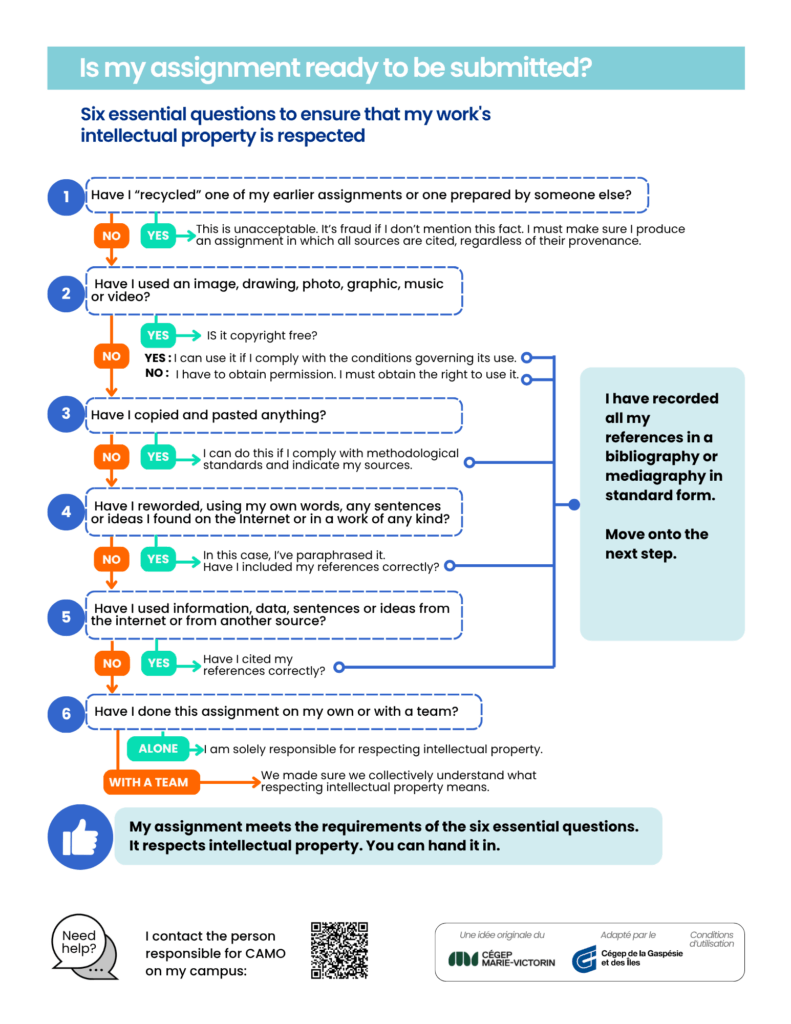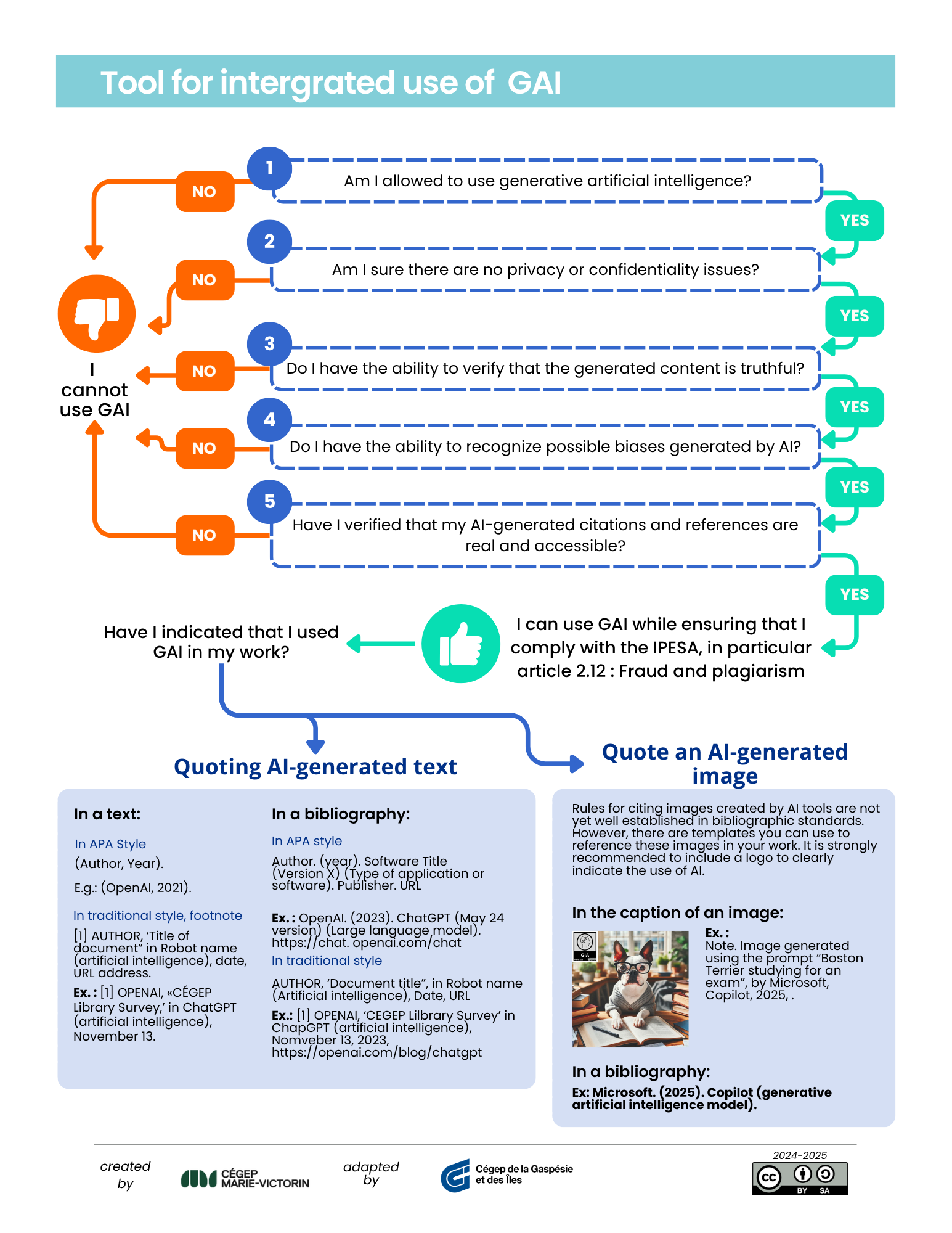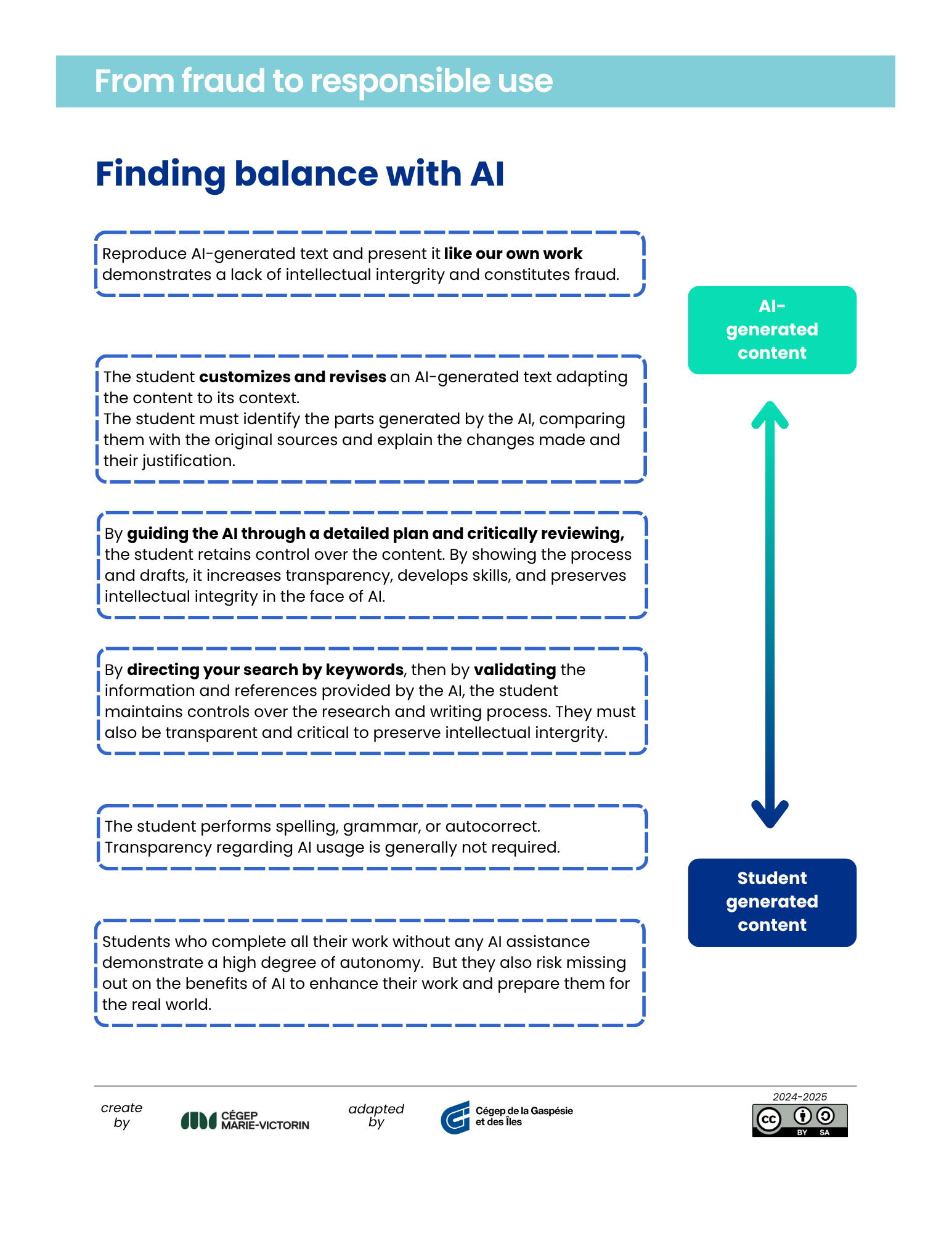Academic integrity is a value that guides actions and is based on respect for knowledge, intellectual curiosity, a passion for research and effort, critical thinking, as well as respect for truth and the work of others, or generated by generative artificial intelligence (AI). […]¹» .
Having integrity helps avoid behaviors such as plagiarism, fraud, and cheating.
1 UNIVERSITÉ DE SHERBROOKE. « Guide de référence sur l’intégrité intellectuelle », Université de Sherbrooke, 2024, https://cegepsherbrooke.qc.ca/wp-content/uploads/2025/02/guide-reference_integrite-intellectuelle-2024-12-03.pdf

Plagiarism
Plagiarism is reproducing words, ideas, data, or images without citing the source; wrongfully claiming someone else’s creation as your own, or purchasing someone else’s work.
Self-plagiarism is submitting work that has already been assessed in another course without the permission of the new teacher.
Electronic plagiarism or cyberplagiarism is:
Copying or paraphrasing electronic content, regardless of the medium (web, email, video, etc.), without citing the source.
Including images, graphs, data (e.g., PowerPoint or Excel files, statistics, and online data) without indicating the source.
Purchasing a ready-made assignment online and submitting it as your own.
Source : UNIVERSITÉ DU QUEBEC EN OUTAOUAIS. « Qu’est-ce que l’intégrité intellectuelle et le droit d’auteur? », UQO, https://uqo.ca/integrite-plagiat/integrite-plagiat
Fraud
Fraud is an act intended to deceive or violate a rule.
Deliberately recording false results or incorrect information, for example, in user files during internships or data collection.
Copying information from another student’s or third party’s computer or emails without citing the source.
Falsifying or using a false document, or attempting to falsify a document submitted to the Cégep or a Cégep document sent or not to a third party, under any circumstances.
Being involved in impersonation during an exam or using or attempting to use another person’s skills.
Colluding or conspiring with someone to commit a fraudulent act.
Buying or selling academic work.
Paying someone to complete an assignment required in a course.
Stealing from or corrupting a person to obtain information.
Committing or attempting to commit any act that could involve the Cégep’s liability.
Source : UNIVERSITÉ DU QUEBEC EN OUTAOUAIS. « Qu’est-ce que l’intégrité intellectuelle et le droit d’auteur? », UQO, https://uqo.ca/integrite-plagiat/integrite-plagiat
Cheating
Cheating means acting dishonestly to gain an unfair advantage over others; it is falsely claiming knowledge.
Taking illegal procedures to know in advance the questions or solutions to an exam or assignment.
Submitting an assignment for evaluation that is essentially the same as one already submitted for evaluation at the Cégep or another educational institution, without prior approval from the teacher.
Copying or attempting to copy in any way during an exam.
Possessing, using, or attempting to use any unauthorized document or material during an evaluation.
Receiving any unauthorized assistance—whether individual or collective—for an assignment or part of an assignment.
Using another person’s copy during a test.
Source : UNIVERSITÉ DU QUEBEC EN OUTAOUAIS. « Qu’est-ce que l’intégrité intellectuelle et le droit d’auteur? », UQO, https://uqo.ca/integrite-plagiat/integrite-plagiat
Cégep's policy
Excerpt from the Learning Evaluation Policy (p. 15–16)
2.12 Fraud and Plagiarism
The Cégep places great importance on preventing plagiarism and upholding academic integrity. Accordingly:
2.12.1 A student who commits plagiarism will receive a grade of 0 for the assignment. Plagiarism is defined as “copying all or part of someone else’s work into one’s own without citing the source.”²
2.12.2 Self-plagiarism is also considered a form of plagiarism. It refers to submitting the same text or assignment multiple times, either simultaneously or consecutively, without prior approval from the teacher receiving the work.³
2.12.3 Any act of fraud, attempted fraud, or collaboration in fraud or cheating results in a grade of 0 for the exam or assignment in question.
2.12.4 The use of artificial intelligence (AI) assistance during an evaluation must be authorized by the teacher. Otherwise, it is considered fraud.
2.12.5 Plagiarism or fraud results in a grade of 0 for the exam or assignment. However, the teacher may, based on professional judgment, apply a different penalty than a grade of 0.
2.12.6 In all cases of fraud or plagiarism, the following process applies:
The teacher must seize the relevant documents and submit a report to the campus administration via the department coordinator or the continuing education advisor.
When the administration receives a first report concerning a student, the report is forwarded to the individual academic advisor of the program so that the appropriate code can be added to the student’s record. This code will remain in the student’s file.
The administration then contacts the student, who must attend a mandatory workshop on academic integrity. In the case of a second offense, the student will receive a final grade of 0 for the course involved, whether it is the same course or a different one. A third offense may result in suspension from the Cégep for the session.
2 plagiat.pdf (uqar.ca)
3 Plagiat et fraude – Enseigner à l’UQTR – UQTR (uquebec.ca)
Acting with integrity at the Cégep
Is my assignment ready to be submitted ?
Here are 6 key questions to help you ensure your work respects intellectual property.

Presenting work according to standards
By consulting the Presenting Work According to Standards section in the Student Zone, you’ll find all the tools you need to help you follow the principles of academic integrity (e.g., how to integrate quotations into your work, paraphrase, and generate footnotes).
The content of this section is taken from the Use of Artificial Intelligence page from Cégep Marie-Victorin and adapted by the Cégep de la Gaspésie et des Îles.
Ethical Use of Artificial Intelligence

Tools for the Ethical Use of Artificial Intelligence
1. Am I allowed to use artificial intelligence?
If you are not, the use of artificial intelligence is not allowed under these conditions.
If you are, the use of artificial intelligence is permitted provided that the other questions ensuring its safe and ethical use have been addressed.
Don’t risk violating the Cégep’s evaluation rules. It’s better to check first than to use AI without permission and risk sanctions for fraud.
2. Am I certain that there are no confidentiality or privacy issues?
If you are not, the use of artificial intelligence is not permitted under these conditions.
If you are, the use of artificial intelligence is allowed only if the other questions ensuring its safe and ethical use have been addressed.
Given the Canadian government’s information security standards, some AI tools—particularly those hosted on U.S. servers—pose privacy risks. The large-scale data collection by these systems raises significant privacy concerns, involving access to various personal information. Such practices can lead to the creation of detailed profiles and data misuse.
To protect your information:
Regularly adjust your privacy settings.
Limit data sharing.
Encrypt sensitive data.
Avoid disclosing personal information.
Understand how AI systems use your data.
The Cégep, through Office365, offers a version of Copilot that requires a login with your institutional email address, thus ensuring the security of your personal data. The information collected by this system remains confidential and is not reused for machine learning or sold for commercial purposes.
3. Do I have the ability to verify that the generated content is accurate?
If you don’t, the use of artificial intelligence is not permitted under these conditions.
If you do, the use of artificial intelligence is allowed only if the other questions ensuring its safe and ethical use have been addressed.
Generative AI tools are fascinating but rely on probabilities based on training data without any real understanding of meaning. Their goal is not truth but statistically probable answers. This can lead to errors, hallucinations, or fabricated facts. Additionally, these tools can easily provide incorrect or nonexistent sources.
Intellectual rigor and fact-checking are essential for ethical AI use. Always verify your sources, because without verification, information is useless.
4. Do I have the ability to recognize possible biases generated by AI?
If you don’t, the use of artificial intelligence is not permitted under these conditions.
If you do, the use of artificial intelligence is allowed only if the other questions ensuring its safe and ethical use have been addressed.
Trained on often biased internet data, AI tools risk generating discriminatory or stereotypical content. As AI becomes increasingly integrated into our daily lives, critical thinking is essential, especially regarding the inherent biases in these technologies.
To detect these biases, question the origin of the data. Increased vigilance is needed regarding biases related to gender, ethnicity, or culture.
By sharpening this vigilance, we work toward responsible, fair, and just AI and actively commit to shaping an ethical digital future.
5. Have I verified that my AI-generated citations and references are real and accessible?
If you didn’t, the use of artificial intelligence is not permitted under these conditions.
If you did, the use of artificial intelligence is allowed only if the other questions ensuring its safe and ethical use have been addressed.
It may be tempting to use AI tools to generate citations and references. However, verifying the accuracy of these sources is crucial.
Take the time to check each citation and reference by consulting the primary sources provided. Ensure that the works and authors do exist and that the quoted passages are accurate. Cross-check with other reliable sources to confirm the credibility of the information. If a reference seems doubtful or cannot be found, do not use it, even if it was generated by AI.
By rigorously validating your sources, you uphold the integrity and quality of your academic work.
6. Have I indicated that I used AI in my work?
When the use of artificial intelligence tools is permitted in an assignment, it is necessary to properly cite the excerpts generated by these tools. Considering the non-reproducible and non-retrievable nature of AI-generated responses, the text used must be quoted verbatim, accompanied by a reference note and the prompt given to the AI.
Please consult the section Citing Artificial Intelligence in Assignments below to learn how to properly cite AI.
Balancing AI Use: From Misuse to Ethical Practice
This chart shows different uses of artificial intelligence in academic work. It highlights practices ranging from fraud to responsible and ethical use of AI tools.
The goal is to help the college community think about the best practices that allow them to benefit from the opportunities AI offers, while preserving academic integrity and supporting skill development.
The examples presented illustrate that there are many ways to integrate AI as a learning support. The key is to find the right balance by cultivating critical thinking and transparency about the use of these tools.

Citing Artificial Intelligence in Assignments
How do I cite AI-generated text in my writing?
AY Style
(Author, Year)
Example: (OpenAI, 2021)
Traditional Style (DIONNE), with Footnote
[1] AUTHOR, “Title of the Document”, in Name of the Bot [artificial intelligence], date, URL address
Example:
[1] OPENAI, “Cégep Québec Library Survey”, in ChatGPT [artificial intelligence], November 13, 2023, [URL].
How do I cite AI-generated text in a bibliography?
AY Style
Author. (Year). Title of the software (Version X) [Type of software or application]. Publisher. URL
Example:
OpenAI. (2023). ChatGPT (May 24 version) [Large language model]. https://chat.openai.com
Traditional Style (DIONNE)
AUTHOR, “Title of the document,” in Name of the bot [artificial intelligence], date, URL address
Example:
[1] OPENAI, “Cégep Québec Library Survey,” in ChatGPT [artificial intelligence], November 13, 2023, https://chat.openai.com
How do I cite an AI-generated image in a bibliography?
The rules for citing images created by artificial intelligence tools are not yet well established in bibliographic standards. However, there are models you can use to reference these images in your work. It is strongly recommended to include a logo to clearly indicate the use of artificial intelligence (SEE SECTION BELOW: Transparency on AI Use).
IN AN IMAGE CAPTION

Note. Image generated using the prompt “cat coming to pay its late fees at a library,” by Microsoft Copilot, 2024.
IN A BIBLIOGRAPHY
Microsoft. (2024). Copilot [Generative artificial intelligence model].
Authorization
First, it is essential to obtain permission from the teacher before using AI tools as part of your assignment. Then, indicate the use of AI tools in your research or writing process.
Responsibility
It is important to note that you are fully responsible for the final content of your work, including any parts produced by AI. You must check, edit, and ensure the accuracy of the information generated by the AI.
Conversation
To incorporate content from an AI conversation, you may include excerpts as direct quotes or paraphrase them while citing the source. If the conversation is long or complex, it may be preferable to include it as an appendix.
Reminder: “[…] copyright means the right to reproduce. As a general rule, only the copyright holder, often the creator, has the right to produce or reproduce the work or to authorize anyone else to do so.”

